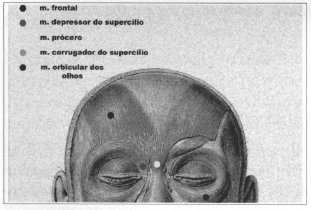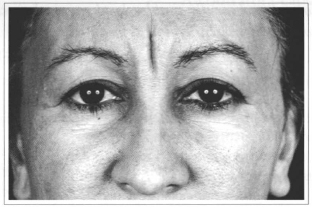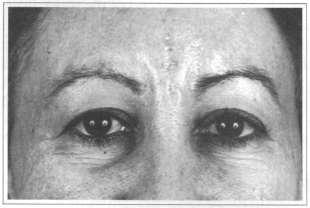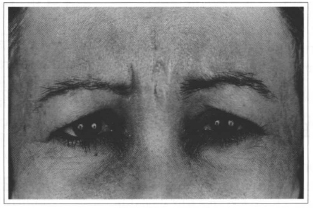

Case Reports - Year 2000 - Volume 15 -
Glabellar Wrinkle - Case Report
Ruga Glabelar - Relato de Caso
ABSTRACT
The case reported is that of a woman with a deep glabellar wrinkle characterized by large skin retraction and deep-plane adhesion. A technically simpler local surgical procedure, employed to repair the vertical furrow with a satisfactory aesthetc result, is described.
Keywords: Glabellar wrinkle
RESUMO
Os autores apresentam o caso de uma paciente portadora de uma ruga glabelar com grande retração de pele e aderências a planos profundos. Neste relato, discute-se a realização de um procedimento cirúrgico local, de maior simplicidade técnica, para a resolução da alteração, com resultado estético satisfatório.
Palavras-chave: Ruga glabelar
Our first impressions of a person often result from an aesthetically appreciation of the other, with special emphasis to the face. Many patients go to a plastic surgeon's office and undergoes different procedures in search of a greater satisfaction with their appearance and a greater social integration. If a person is dissatisfied with his/her appearance, he/she frequently withdraws from social contact.
Our patient was a 34-year-old female patient who has presented a deep glabellar wrinkle with a marked retraction and deep-plane adhesion since her teens. A technically simpler local procedure repaired the vertical furrow with a satisfactory aesthetic result.
ANATOMICAL REVIEW
The muscles of facial expression share the following characteristics: (1) they are superficially located with one of their insertions (or influence) on the skin; (2) greatly variable development degree, shape, and strength; and (3) innervation by the facial nerve(1).
The muscles at the upper-third of the face important to facial expression are the musculus occipitofrontalis, the musculus orbicularis oculi, the musculus depressor supercilii, the musculus corrugator supercilii, and the musculus procerus.
The origin of musculus corrugator supercilii is the nasal part of the frontal bone (the medial end of the superciliary arch) and its insertion is on the skin of eyebrow, while the origin of musculus procerus is at the dorsum of the nose and the lateral nasal cartilage (fascia over nasal bone) and its insertion is on the glabella skin (skin of forehead). Both muscles are innervated by temporal branches of the facial nerve and act upon the forehead (glabella) and the eyebrow skin(2) (Fig. 1).

Fig. 1- Anatomy of the upper third region of the fuce.
CASE REPORT
TPR, female, 34 years old, white, had a deep glabellar wrinkle (approximately 2.5 cm long by 0.4 em deep) with a marked hypertrophy of the corrugator and the procerus muscles (Fig. 2). When the patient was asked to wrinkle the forehead, we observed a deep-plane adhesion accompanied by a symmetrical accentuation of the adjacent muscle hypertrophy.

Fig. 2 - Preoperative period.
TREATMENT
The patient was operated under local anesthesia. An elliptical resection en bloc of the affected area was made up to the periosteum, followed by dissection of approximately 2 cm of the glabellar area adjacent to the incised area and partial excision (resection) of the corrugator and procerus muscles, which were responsible for the expression wrinkle vice.
Closure by planes was made, using colorless 4-0 vycril (inverted simple stitches) for deep plane sutures and 6-0 mononylon (single stitches) for skin suture. Skin stitches were removed seven days after surgery.
Dressing was made with Micropore and local compression was kept for 24 h. The patient returned to follow-up weekly during the first 28 days and monthly thereafter. Figure 3 shows the patient three months after surgery.

Fig. 3a - Postoperative period.

Fig. 3b - Postoperative period.
DISCUSSION
Glabellar wrinkles result from muscle contraction of the corrugator and procerus muscles. Different repair techniques for glabellar wrinkles have been used, including damage of the nerves innervating these muscles (Castanares(3), 1964) and, more commonly, segmental resection or muscle division (Kaye(4), 1977). An extended resection of the corrugator and procerus muscles is required for a long-term sustained correction. The usual approach is via coronal incision. Knize(5) has described the technique of resecting the corrugator and procerus muscles through the upper blepharoplasty incision, with no effect upon blepharoplasty(6).
Other approaches and techniques could be used in glabellar wrinkle correction, such as the use of botulin toxin to suppress muscle contraction, and videoendoscopy approach. The botulin toxin produces a transient aesthetic result, and a more aggressive procedure is required with three incisions if videoendoscopy approach is used.
After talking to the patient, we decided for direct resection of the wrinkle because the vertical scar would be less pronounced than or very similar to the glabellar wrinkle with the advantage of not having any associated deformity and also because this approach would make surgical treatment easier. The chosen method gave a satisfactory aesthetic result, and the patient considered it very satisfying.
REFERENCES
1. GARDNER E, GRAY DJ, OI Rahilley R. Anatomia. 4. ed. Guanabara : Rio de Janeiro, 1988. p. 644.
2. FERNER H, STAUBESAND J, SOBOTTA. Atlas de Anatomia Humana. Editora Guanabara, Rio de Janeiro. 18. ed., 1982. p. 148.
3. CASTANARES S. Forehead wrinkles, glabelar frown and ptosis of the eyebrows. Plast. Reconstr. Surg. 1964;34:406-10.
4. KAYE B. The forehead lift. Plast. Reconstr. Surg. 1977;60:161-3.
5. KNIZE DM. Transpalpebral approach to the corrugator supercilli and procerus muscles. Plast. Reconstr. Surg. 1995;95:52-7.
6. FREUND RM, ASTON S. Blefaroplastia. In: CASTRO CC. Cirurgia de Rejuvenescimento Facial. Medsi : Rio de Janeiro, 1998. pp. 267-96.
I - Adjunct professor and head of Plastic Surgery Discipline at Faculdade de Ciências Médicas da Universidade do Estado do Rio de Janeiro.
II - Assistant professor of Plastic Surgery Discipline at Faculdade de Ciências Médicas da Universidade do Estado do Rio de Janeiro.
III - Resident at the Plastic Surgery Discipline of Faculdade de Ciências Médicas da Universidade do Estado do Rio de Janeiro.
Address for correspondence:
Claudio Cardoso de Castro, MD
R. Teresa Guimarães, 42
22280-050 - Rio de Janeiro - RJ Brazil


 Read in Portuguese
Read in Portuguese
 Read in English
Read in English
 PDF PT
PDF PT
 Print
Print
 Send this article by email
Send this article by email
 How to Cite
How to Cite
 Mendeley
Mendeley
 Pocket
Pocket
 Twitter
Twitter